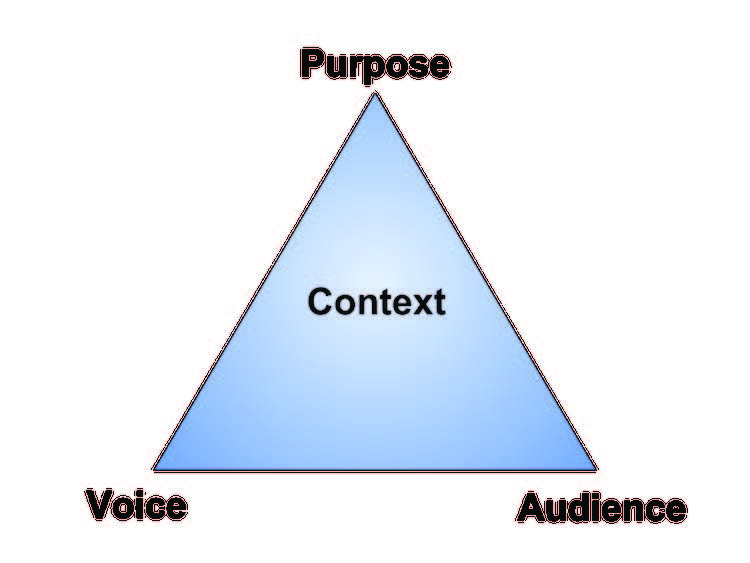Ch. 14 PURPOSE
- Page ID
- 53495

For many students, Aristotle’s Rhetorical Triangle presenting the three modes of persuasion – logos, pathos, and egos – becomes lost in the trees of misremembered concepts. Our revised triangle applies Aristotle’s ideas directly to today’s modes of writing, demanding purpose, awareness, and intentionality every time we write. [Image: Arnaud Mesureur | Unsplash]
DEFINITION TO REMEMBER:

A 21st Century Rhetorical Triangle
RULES TO REMEMBER:
1. When we learn to write in our elementary years, we are given a prompt or question and asked to write:
◦ Describe your summer vacation.
◦ Outline the life cycle of the butterfly.
◦ Write a biography about someone famous in American history.
Our purpose is to satisfy the prompt and earn approval from our teacher. For many of us, that academic sense of purpose carries on into our high school and college years. Our purpose for writing comes externally from whomever has given us the assignment – a reliance that often leads to resentment when we have no interest in the purpose we have been given.
But an external purpose will rarely lead to inspired writing. Our best writing comes when we have an internal purpose: a reason to communicate that is inspired, energetic, and infectious.
2. Discovering purpose is your responsibility as a writer. No one wants to write about something distasteful or dull, but sometimes we are called to the challenge. When you are given a prompt, how will you locate a nugget of interest? What can you bring to the topic that is uniquely from you, your life, or your experiences? What additional research might help you discover something new and intriguing? What passions or future interests do you have that you might tie to the topic?
3. As you ponder purpose, consider the following questions:
◦ When did you first notice or experience this issue?
◦ What is the most challenging part of this issue?
◦ What are some of the main causes of this issue?
◦ Is there a situation or scene that is typical of this issue?
◦ What do people stand to win or lose with regard to this issue?
◦ Is what is at stake here inherently interesting to some people? Who are those people?
4. Only write what you would want to read. Consider the following prompt:
◦ Write a five-paragraph paper about the floor beneath your feet. If this were your assignment for the next two hours, what would you do? What kind of essay would interest you as a reader? Even if you are in a room with dull brown carpet, here are some possibilities:
▪ a history of carpet manufacturing
▪ an exploration of flammability and safety
▪ the impact of color on a room
▪ a memory of a similar childhood carpet
▪ a story about grandparents who believed in brown
▪ an explanation of how to lay carpet
▪ an informational piece about who and how to hire carpet layers
▪ an essay about choosing carpet wisely
▪ an argument about carpets and allergies
▪ a list of curious facts about carpets in American homes
Your purpose is up to you, regardless of how limiting a prompt may seem. Choose a direction that interests you, and find ways to connect with your topic so your purpose becomes internally driven rather than externally given.
5. Always prewrite. Prewriting comes in a variety of approaches, and it is up to you to discover what works best as you ponder a new idea. Keep in mind that prewriting does not have to mean sitting at a desk with your fingers on the keyboard. Some of the best prewriting happens when you are walking or driving or eating or taking a shower. Here are some options for effective prewriting as you discover your purpose:
◦ brainstorming
◦ clustering / mindmapping
◦ freewriting
◦ journaling
◦ outlining
◦ question-asking
◦ looping
Remember: Prewriting does not necessarily mean writing. Some writers need to get their ideas down on paper or on a screen, while others prefer to mull ideas as they go about other tasks. Experiment with options until you discover what is most effective, efficient, and inspiring for you.
6. Ask yourself, So what? Why does your purpose matter? To whom does it matter? And does it really matter?Learn to ask yourself So what? continually and consistently throughout the writing process. The more often you ask, the less often your readers will feel the need to ask.
“I remind my children that regardless of any future personal and professional goals, always remain vigilant in the art and science of storytelling and story-writing. Your writing and grammar skills will improve, thereby presenting you as polished, sophisticated, and a benefit to your guild.” Patrick F. O’Neal, Pastor
COMMON ERRORS:
• Writing to a prompt without pondering a deeper sense of purpose. When you are uninspired, your readers will be uninspired as well. Before you write, always take time to discover a reason for writing.
• Blaming the prompt-giver for your own lack of interest. The onus is on you to find your purpose, regardless of how uninspiring a prompt may be. Boring people are bored. What tools can you use to bring inspiration and energy to every new writing task?
• Not taking the time necessary to prewrite and ponder. Few of us can sit down cold to a writing prompt and produce excellent work. While we are sometimes called to do that, most situations allow a few days or hours before we need to begin writing. Use that time wisely.
• Neglecting to focus on a purpose that is broad enough to allow for discussion but narrow enough to be manageable.
EXERCISES:
| Exercise 14.1 |
|
Consider five writing tasks that you have completed recently, whether for school, work, or home. What was the purpose of each? Did you feel a personal connection to that purpose, or was it assigned to you? How might you have approached each task differently to ensure that your purpose was internal rather than external? 1. 2. 3. 4. 5. |
| Exercise 14.2 |
|
Consider the following topics. If you were asked to write a brief essay on each, what approach would you take that would interest you? How do you ensure that you write something you would enjoy to read, and that you effectively answer the question So what? 1. Politics 2. Baseball 3. Child-rearing 4. Part-time jobs 5. Recycling 6. Gardening 7. Space exploration 8. Capitalism 9. Religion 10. Education |
| Exercise 14.3 |
| Consider a writing assignment that you will need to complete in the next week. What is the assignment, and why must you complete it? What will your purpose be in writing this assignment for your audience? Will this be something you would want to read?Why or why not? How will you effectively answer the question So what? |

